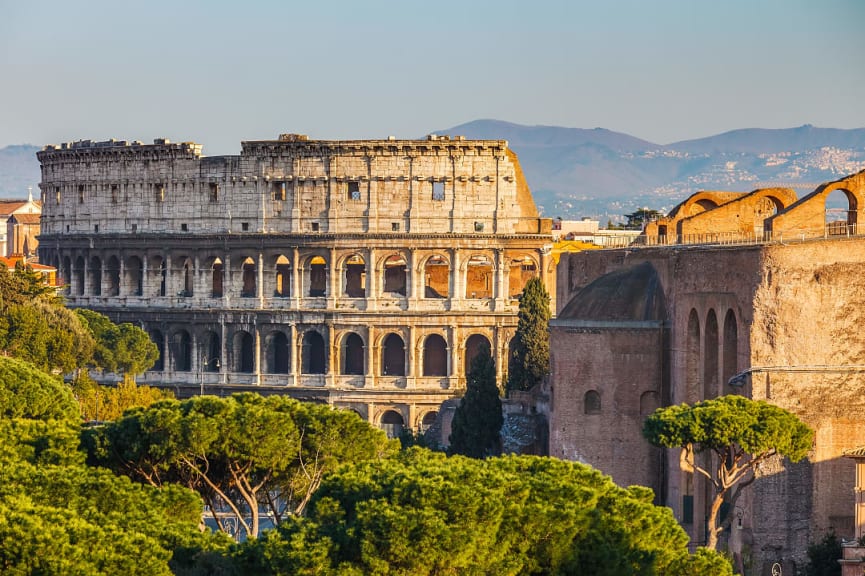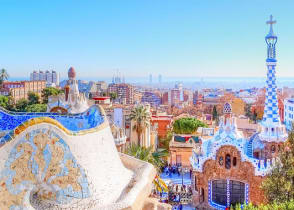Spain vs Italy: Where Should I Travel?

Luxury vacation on the Mediterranean Sea in Spain.
Spain and Italy are Mediterranean masterpieces that overflow with cultural riches, culinary excellence, and historical treasures. Both nations are filled with passionate energy and timeless charm, yet each speaks to travelers in a different way. Italy beckons you with Renaissance grandeur and ancient Roman ruins, while Spain entices travelers with Moorish palaces and modernist marvels.
Italy seduces travelers with its artistic legacy and regional cuisines, while Spain will enchant you with its vibrant festivals and diverse landscapes. Each country has unique approaches to luxury travel, from converted palazzo hotels and legendary vineyards to exclusive coastal resorts and cultural experiences that exist nowhere else. When deciding between these captivating destinations, consider what ignites your wanderlust.
This guide will lead you through the heart and soul of Spain and Italy to help you discover which destination resonates with your travel aspirations.
Where is Spain?

Tossa de Mar in Catalonia, Spain.
Spain embraces its position on the Iberian Peninsula in southwestern Europe, where diverse cultures and stunning landscapes converge. Bordered by Portugal, France, and Andorra, with Gibraltar to the south, its coastlines stretch along the Mediterranean Sea and Atlantic Ocean for a remarkable variety of coastal experiences that you can enjoy when visiting the Catalonian Coast amid Barcelona and Costa Brava.
The landscapes of the Spanish mainland unfold as though on the canvas of a master landscape artist. Sun-drenched Mediterranean beaches contrast with the lush hills of Galicia, while the majestic Pyrenees Mountains guard the northern border. The central plateau showcases vast plains dotted with ancient castles and the Sierra Nevada presents snow-capped peaks just hours from tropical coastlines. This geographical diversity shapes Spain's regional identities, from the lush Basque Country to the sun-baked plains of Andalusia.
Where is Italy?

Photo courtesy of: Richard Waite Anatara Convento Di Amalfi Grand Hotel.
Italy extends like an elegant boot into the Mediterranean Sea, bridging central Europe with the ancient worlds of Greece and North Africa. Surrounded by five seas and sharing borders with France, Switzerland, Austria, and Slovenia, the country’s position has made it a crossroads of civilization for millennia.
The Italian landscape tells a story of dramatic contrasts that you can gain insight into on our a splendors of Italy tour. The Alps rise majestically in the north, their peaks giving way to the fertile Po Valley. The Apennine Mountains form the peninsula's backbone, creating distinct regions on either side. Tuscany's rolling hills and cypress trees paint picture-perfect scenes, while the Amalfi Coast's dramatic cliffs plunge into azure waters. From the volcanic landscapes of Sicily to the lagoons of Venice, each region presents its own natural beauty.
What are the Similarities Between Spain and Italy?

Family in Barcelona, Spain.
Both nations are pillars of Mediterranean culture, where life revolves around family, food, and celebration. Their respective cuisines rank among the world's most beloved, with both treating meal times as sacred social occasions that bring people together. Each has gifted the world with iconic dishes like gazpacho and seafood gnocchi featuring mussels and shrimp, and their wine traditions have influenced global gastronomy. You can get a taste of this on our luxury food-lover's tour of Tuscany and Umbria or our Spanish food, wine, and culture tour.
Spain and Italy share deep historical connections, from Roman heritage to medieval Christian influence. Both boast an extraordinary number of UNESCO World Heritage sites, preserving ancient ruins, medieval towns, and architectural treasures. Their cities unveil similar patterns of historical development, with characteristic plazas and squares serving as social hubs.
The nations embrace a similar approach to daily life, where quality time with family and friends takes precedence. Both cultures celebrate the art of the afternoon stroll and maintain strong regional identities that contribute to their cultural richness. For a luxury dive into this deep culture, consider our authentic culinary and culture tour of Spain or highlights and hidden culture journey through Italy.
What are the Differences Between Spain and Italy?

Spaghetti alle Vongole, Italy.
Daily rhythms distinguish these Mediterranean cousins. Spain follows a notably later schedule, with lunch typically starting around 2pm and dinner rarely beginning before 9pm. While both countries value leisure time, Spain's siesta culture has shaped its business hours and social patterns differently from Italy's more conventional European schedule.
Artistic and architectural heritage follows distinct paths in each nation. Italy's classical Roman ruins and Renaissance masterpieces emphasize symmetry and proportion, and can be investigated on our immersive tour of Italy. Spain's mix of Moorish, Gothic, and modernist influences creates more eclectic architectural landscapes that can be witnessed on our best of Spain tour. Italian art focuses heavily on Classical and Renaissance periods, while Spanish art spans from geometric Islamic patterns to surrealist innovations.
Does Spain or Italy Have Better Beaches?

Cala Salada Beach in Ibiza, Spain.
Each country has distinctive coastal experiences that cater to different preferences. Spain's extensive coastline features long stretches of golden sand, particularly along the Costa del Sol and Costa Brava. Spanish beaches typically provide more developed tourism infrastructure and consistently warm weather throughout a longer season that you can enjoy on our Coasts of Spain Tour: Atlantic to Mediterranean.
.
Italy's beaches tell varied stories. The Amalfi Coast combines pebbled shores with dramatic cliff settings, while Sardinia boasts Caribbean-like white sand and crystal waters. The Italian Riviera presents a mix of rocky coves and elegant beach clubs, while Sicily offers volcanic black sand beaches alongside golden shores. These iconic destinations can be experienced on our luxury Italian Adventure to Rome, Amalfi Coast, and Sicily.
For pure beach vacation experiences, Spain often edges ahead with its warmer waters and more extensive sandy coastlines. However, Italy's beaches typically integrate more seamlessly with historical towns and cultural attractions for combinations of swimming and sightseeing. The "better" beach destination depends on whether you prioritize traditional beach activities or a combination of coastal relaxation and cultural exploration.
Does Spain or Italy Have Better Castles?

Fortress Alcazar of Segovia in Spain.
Spain and Italy boast a rich heritage of castles, but their styles and historical contexts differ significantly. Spain is home to some of the most stunning castles in Europe, such as the iconic Alhambra in Granada, which showcases intricate Islamic architecture and lush gardens that reflect the country's Moorish past. Other notable examples include the fairy-tale Segovia Castle, which inspired Disney, and the medieval fortress of Loarre, known for its remarkable preservation. These castles not only serve as historical landmarks, but also offer breathtaking views and insights into Spain's diverse history of conquests and reconquests.
Italy presents an array of castles that often reflect its feudal past and Renaissance grandeur. The Castello Sforzesco in Milan and the imposing Castel del Monte in Apulia are prime examples, each with unique architectural features that tell stories of power and artistry. Italian castles often served dual purposes as fortresses and luxurious residences for nobility, showcasing elaborate frescoes and opulent gardens. The romantic allure of these structures is complemented by their picturesque settings amidst rolling hills and vineyards, making them a favorite for those seeking history and beauty.
Choosing between Spain and Italy for castle exploration depends on your personal preference. If you are drawn to the enchanting Moorish architecture and vibrant history of Spain, then castles like the Alhambra may be more appealing. Those who appreciate Renaissance art and fortified elegance might find Italy's castles more captivating. Both countries offer extraordinary experiences that reflect their unique cultural identities, making either choice a rewarding adventure.
What Are the Top Activities in Spain?

Gothic Quarter in Barcelona, Spain.
Spain brims with energy and tradition. Wander through Barcelona's Gothic Quarter before marveling at Gaudí's surreal architecture on a luxury tour of the country. Feel the passionate rhythms of flamenco in a Seville tablao, where dancers transform emotion into movement. Explore Madrid's Golden Triangle of Art, home to masterpieces by Velázquez, Goya, and Picasso.
The Camino de Santiago beckons pilgrims and adventurers, winding through medieval villages and lush countryside. In the Rioja region, tour centuries-old wineries carved into hillsides. San Sebastián's pintxos bars provide a taste of the country's culinary innovation, while Valencia celebrates traditional flavors in dishes like paella.
Witness the running of the bulls during Pamplona's San Fermín festival or join the world's biggest food fight at La Tomatina. Granada's Alhambra Palace reveals Islamic Spain's refined artistry, while Córdoba's Mezquita demonstrates the harmonious blend of religious architectural styles.
What Are the Top Activities in Italy?

Medieval town in Siena, Italy.
Italy can overwhelm your senses with historical and artistic treasures. Rome's Colosseum and Forum transport you to the ancient world, while Vatican City houses incomparable artistic masterpieces. Florence's Uffizi Gallery showcases Renaissance genius and Venice's canals create a floating museum of architectural splendor that you can experience on a luxury trip to the country.
Tuscany invites exploration of hilltop towns like San Gimignano and Siena, where medieval towers pierce the sky. Learn traditional cooking in Italy's gastronomic capital, Bologna, or hunt for truffles in Piedmont's autumn forests. The Amalfi Coast Drive winds past pastel-colored villages clinging to cliffs, while Sicily's Valley of the Temples preserves Greek civilization's grandeur.
Milan's fashion districts showcase Italian style, while Lake Como's elegant villas epitomize lakeside luxury. In the Dolomites, hiking trails lead to alpine meadows and jagged peaks. Naples birthed pizza and maintains its reputation for the world's finest, while nearby Pompeii provides an unprecedented glimpse into Roman daily life.
Is it Easier to Travel to Spain or Italy from the US?

Grand Via in Madrid, Spain.
Italy offers more direct flights from major US cities to Rome and Milan. Spain's primary airports in Madrid and Barcelona have fewer direct connections, but service is expanding. Both countries maintain excellent internal transportation networks, with Italy's high-speed rail system providing somewhat faster connections between major tourist destinations.
Choose Spain For:

Flamenco dancers in Madrid, Spain.
- Moorish architecture and Islamic heritage sites
- World-class modern art and architecture
- Diverse regional cultures and languages
- Vibrant festivals and celebrations
- Extended beach seasons and warmer waters
- Outstanding tapas and wine culture
- More affordable luxury experiences
Spain offers an intoxicating blend of Moorish and modern architecture, diverse regional cultures, and Mediterranean beaches. It is an exceptional destination for cultural immersion and sensory delights, and you can find out more by taking a look at our Spain tours and vacations.
Choose Italy For:

Roman Colosseum in Italy.
- Unparalleled concentration of art history
- Ancient Roman ruins and Renaissance treasures
- Renowned fashion and design culture
- Classical music and opera traditions
- Diverse regional pasta and wine specialties
- Picturesque hill towns and villages
- Iconic lakes and alpine scenery
Italy will captivate you with its unrivaled artistic heritage. From ancient Roman ruins to Renaissance masterpieces complemented by world-class fashion, charming hill towns, and stunning alpine landscapes, you can experience it all with our Italy tours and vacations.
Discover More About Spain and Italy

Couple in Marbella, Spain.
Whether you choose Spain's passionate energy and diverse regions or Italy's artistic legacy and culinary traditions, both countries promise extraordinary experiences. Your decision might hinge on whether you seek Spain's more relaxed pace and modernist flair or Italy's classical grandeur and Renaissance richness. Either guarantees unforgettable moments, world-class accommodations, and immersion in some of Europe's most captivating destinations.
For more inspiration and detailed guides on luxury travel experiences to help you decide, explore our Spain travel guide and Italy travel guide.
Life-Enriching Travel Designed Just for You
- 1
Trips curated by the world’s top destination experts
- 2
Concierge-level service leading up to and during your trip
- 3
Unique, exclusive experiences and insider access





